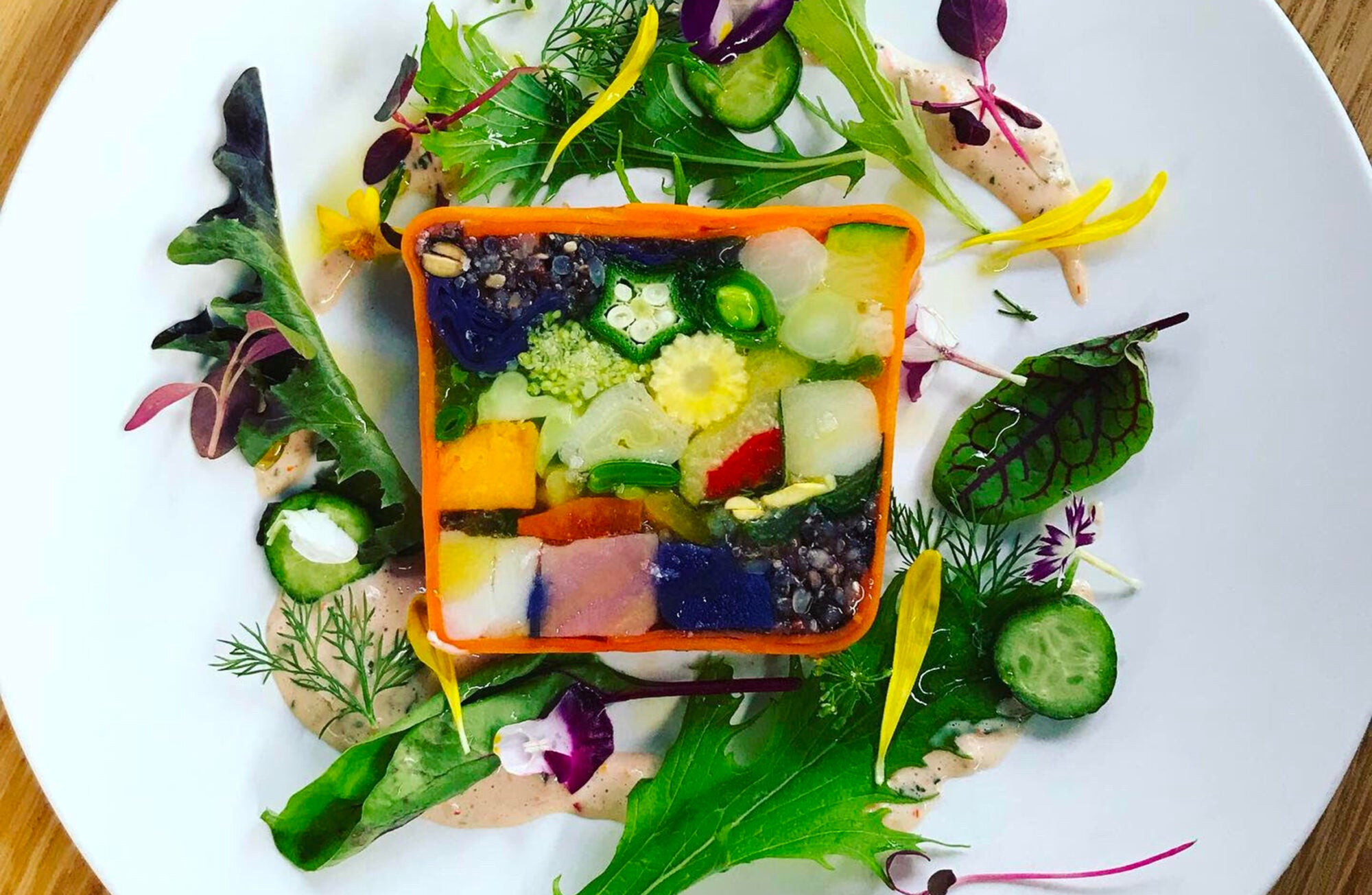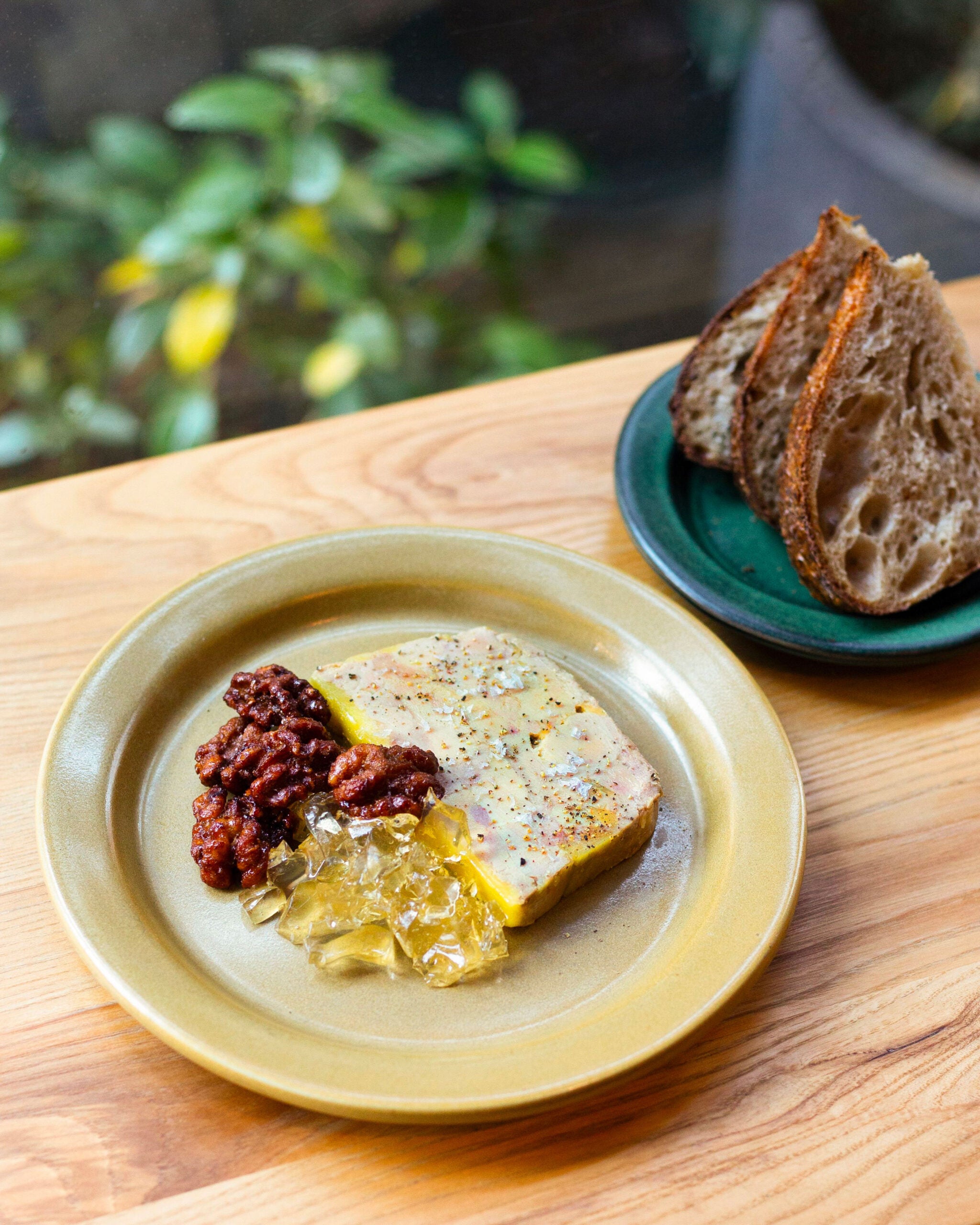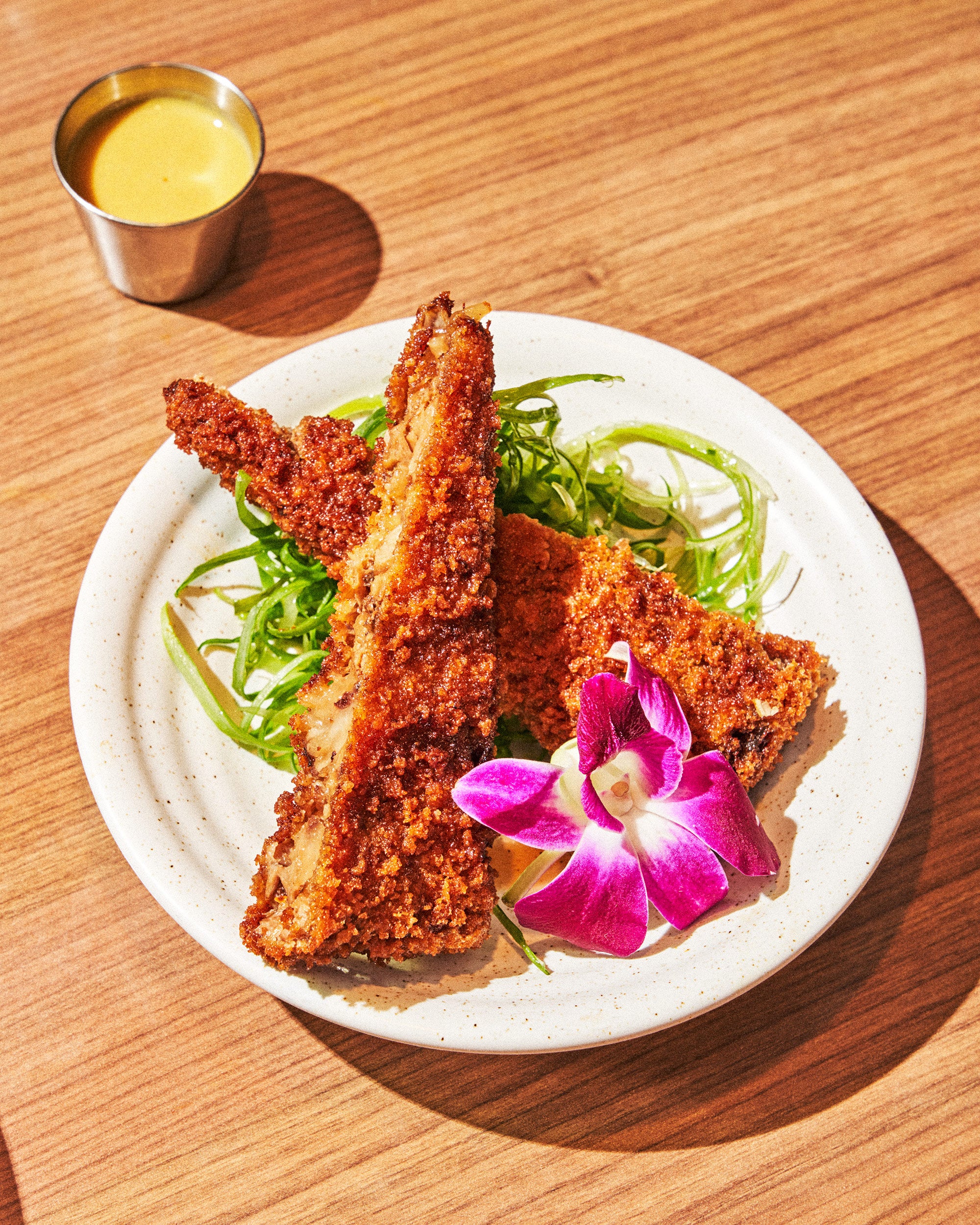
The charcuterie staple is trying out new looks, and New York City is eating it up.
Terrines are divisive. For some, the amalgam of meat and aspic is a queasily retro dish best left in the ’70s dinner parties of the past. Perhaps it comes down to construction. Everything is on display: layers of expertly pureed liver snuggled into jiggly pork fat, sometimes offset by jammy dried fruit or the occasional vegetable. There is no plating to hide behind, no triple-reduced sauce to pour over. As a single forkful proves, you either like terrines or you don’t. And recently, I’ve been on a mission to like them more, because the ever-evolving dish is finding new ground in New York City.
Terrine is believed to have originated in medieval France as a charcuterie staple, but it’s been adapted by countries like the United Kingdom and Vietnam, and now by the borderless wilds of social media. I was recently entranced by a video of a highly colorful, decidedly unmeaty terrine made by the Tokyo-based restaurant Bistro Inocchi, featuring a kaleidoscope of vegetables like okra and purple potatoes set with chicken soup jelly. The dish went viral with baffled comments, incredulous that a dish this intricate could possibly be good: “babe what’s wrong? you’ve barely touched your tiny miscellaneous rainbow items in orange trapezoid loaf.” Bistro Inocchi eventually updated the caption to clarify, “This is food.”
A terrine isn’t just food. It’s slow food in full saturation, requiring a three-day process of prepping, poaching, and pressing. A terrine is named for the vessel it’s assembled in, typically a neat earthenware rectangle with sloping corners and smooth sides. While a pâté is cooked and then pureed and roughly shaped, a terrine is cooked in the loaf pan itself. There is often a variety of textures, with squishy pockets of fat melting into dried fruit or boiled eggs. At the end, anything from kitchen scraps like hearts to precious foie gras has been transformed and reborn as a work of its own.
“It’s an almost perfect plate: a curated, organized piece of protein seasoned with whatever aromatics the chef likes,” says Joshua Pinsky, chef and co-owner of the highly regarded Manhattan restaurant Claud, which has served terrines since day one. “As simple and rustic as it seems, it’s a very thoughtful, technique-driven item.”

Foie gras terrine from Claud by Karissa Ong
At Claud, the terrine isn’t adulterated with a mix of meat, vegetables, or cream. It’s pure Hudson Valley foie gras, seasoned simply with salt and sugar, then poached and pressed. Each opulent slice is served with candied walnuts and a vinegar honey jam. As Claud is a wine bar, the jam is a Francophile’s nod to the practice of pairing foie gras with a somewhat acidic wine to cut through all that fat. “You’d probably get a sweetened ice wine type Sauternes or a Riesling for the pairing of the foie gras, but this is an à la carte restaurant, so I’ll give you the pairing in one dish,” says Pinsky. He originally wanted to serve a rotation of three terrines, inspired by a research trip to the terrine-laden counter at Holborn Dining Room in London. Instead, the foie has become the singular staple.
London is where my terrine fixation took root, too. When I visited the city last December, it felt like every cool wine bar and French-accented bistro was serving terrine. As a later-in-life pork eater, unctuous terrine feels like the final boss in a pork products video game. I liked it best at the lauded Hackney bistro Cafe Cecilia, where the pork was studded with jammy apricots, served with a scattering of cornichons and plenty of charred bread to smear it all atop.
But the terrine that truly transfixed me was back in New York, at the Vietnamese pop-up Ha’s Đặc Biệt’s two-day stint at Gem. Chefs Anthony Ha and Sadie Mae Burns borrow from Vietnam’s canonical pâté nước mum, using lemongrass, five spice, fish sauce, and cloudy, powerfully fermented nước mum—a common ingredient in Vietnamese terrines—to season a mix of pork shoulder, back fat, and leftover duck scraps like meat and liver, all processed in a big grinder scored off Facebook Marketplace from a guy making venison sausage. The mixture is transferred into Le Creuset molds (another Facebook Marketplace score) and cooked before being topped with pickled daikon radish and a drizzle of olive oil. “It’s common to use a pickled aspect, like mustard greens, to add texture and acid that cut the fat,” says Ha. “We top ours with olive oil, which would not be so traditional, but we think it works really well to add this fatty brightness that pairs well with fish sauce.”
Ha’s Đặc Biệt fittingly began experimenting with terrines while cooking in Paris at the legendary Bistrot Paul Bert in 2022, but Ha and Burns have been heartened to see that the appeal has become just as strong stateside. “At the last pop-up at Gem, the terrine was surprisingly popular,” says Burns. “New York is in a bit of a Francophile moment, so I think people are more accustomed to eating the terrines and more excited by it. But I was shocked: We sold so much of it that it seems people are as excited about terrine here as they are in Paris.”
Across the East River, at Eric Sze’s Taiwanese restaurant Wenwen in Greenpoint, terrine dives into the deep fryer. A panko-crusted pork terrine debuted on the menu in early February, originally appearing as a collaboration with the English bistro Lord’s in Manhattan last summer. The restaurants teamed up for “Wenbledon,” a Taiwanese British pop-up held on the first day of Wimbledon. Sze was inspired to create a Taiwanese riff on Lord’s crispy pig’s head terrine. He loved it so much that he brought it back as a permanent menu item to an “overwhelmingly positive” response. One look at the hefty, crispy, fried item, and I believe him.

Fried pork terrine from Wenwen by Adam Friedlander
Sze admits he’s taking a bit of a liberty with calling this dish a terrine, since it isn’t layered. Instead, it’s a three-day process of braising highly gelatinous pork cuts like trotters, hocks, and ears, chopping up the meat, and pouring it into the mold, along with a hint of gelatin to help everything set while staying moist. “The cold broth becomes Jell-O that encases all the gelatinous pork,” says Sze. “There is a ‘pork Jell-O’ commonly found in northern Chinese cooking that does find its way through Taiwan. Nobody in Taiwan breads that pork and fries it though.” The resulting bite is a master class in textural contrast—crispy breading yielding into an almost gooey, meaty bite, dipped into a pool of hot Taiwanese mustard on the side.
The appearance of more terrines isn’t just capitalizing on hype. It’s a way for restaurants to make the most out of the meat they order, giving offcuts and scraps a chance at transformation. “Hopefully, when we have our own restaurant, we’ll be doing a lot more meat production,” says Burns. “It’s definitely more sustainable, and it’s also a great way to repurpose without needing to render out a lot of duck breasts.” And if slipping a spoon into poached meat doesn’t have personal appeal, there’s always the deep fryer.